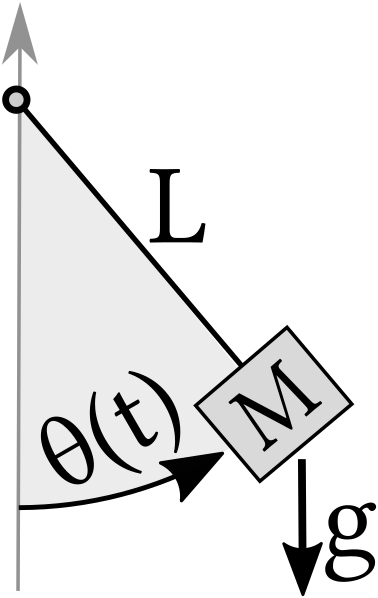- 1.3 Order-of-magnitude guesses
1.3 Order-of-magnitude guesses
Many physical quantities take a value close to one when they are expressed in their “natural” dimensionless units. When the choice is unique, then clearly it is also natural. Otherwise, the appropriate choice is a matter of experience. We will come back to this when we employ non-dimensionalization in the forthcoming discussion. We demonstrate this based on a discussion of
 Figure 1.3: Pendulum discussed in Example 1.10
Figure 1.3: Pendulum discussed in Example 1.10
Example 1.10 The period of a pendulum
We consider a pendulum of mass $M$ attached at a stiff bar of negligible mass.
With this bar it is fixed to a pivot at a distance $L$ from the mass
such that it can swing in a gravitational field inducing an acceleration $g$.
In this example we make use of the fact that the bar has fixed length $L$,
and describe the position of the mass by the angle $\theta(t)$
(see Figure 1.3).
As discussed in Example 1.8 the time unit for this problem is $\sqrt{L/g}$.
Hence, we estimate that the period $T$ of the pendulum is of the order of
$
T \simeq \sqrt{L/g}
$.
Explicit calculations to be performed later on will reveal that this estimate is off by a factor $2\pi$
when the amplitude is small, $|\theta(t)| \ll 1$.
For large oscillation amplitudes $\theta_0$ the period will increase further,
tending to infinity when $\theta_0$ approaches $\pi$.
Hence, we conclude that
\[
T = f(\theta_0) \sqrt{L/g}
\qquad \text{with} \quad
f(\theta_0) \simeq 2 \pi
\text{ for } \theta_0 \ll 1 \, .
\]
Example 1.11 The speed of Tsunami waves
A Tsunami wave is a water wave that is generated by an earth quake or an underwater land slide.
Typical wave lengths are of an order of magnitude $\lambda = 100\,\text{km}$.
They travel through the ocean that has an average depth of about $D = 4\,\text{km}$,
much smaller than $\lambda$.
Therefore, we expect that the wave speed $v_{\text{Tsunami}}$ is predominantly set by the ocean depth and the gravitational acceleration
$g \approx 10\,\text{m/s$^2$}$, i.e.
\[
v_{\text{Tsunami}} \approx \sqrt{ g D } = 2 \times 10^{2}\,\text{m/s} \approx 700\,\text{km/h}
\]
This estimate
suggests that the 2004 Indian Ocean Tsunami traversed the distance from Indonesia to the East African coast,
$L \approx 10\,000\,\text{km}$, in about
\[
\frac{L}{ v_{\text{Tsunami}} }
\approx \frac{ 1 \times 10^{4}\,\text{km}}{ 700\,\text{km/h} }
= \frac{100}{7}\,\text{h}
\approx 15\,\text{h}
\]
This is very close to the value of $16\,\text{h}$ reported in Wikipedia.
Example 1.12 The period of Tsunami waves
In spite of their speed and devastating power, Tsunamis are very hard to detect on the open sea
because their period $T$ is very long.
It can be estimated as the time that the wave needs to run once through its wavelength1)
\[
T \approx \frac{\lambda}{ v_{\text{Tsunami}} }
= \frac{ \lambda }{ \sqrt{ g D } }
= \frac{ 100\,\text{km} }{ 700\,\text{km/h} }
= \frac{1}{ 7\,\text{h} }
\approx 10\,\text{min}
\]
Here, our estimate is too small by about a factor of three.
We conclude that estimates based on dimensional analysis provide valuable insight in time scales of physical processes, even in situations where a detailed mathematical treatment is very delicate.
Self Test
Problem 1.5:
Printing the output of Phantom cameras
With a set of three phantom cameras one can simultaneously follow the motion of $100$ particles
in a violent 3d turbulent flow.
Data analysis of the images provides particle positions with a resolution of $25\,000$ frames per second.
You follow the evolution for $20\,\text{minute}$,
print it double paged with $8$ coordinates per line and $70$ lines per page.
A bookbinder makes $12\,\text{cm}$ thick books from every $1000$ pages.
You put these books into bookshelves with seven boards in each shelf.
How many meters of bookshelves will you need to store your data on paper?
